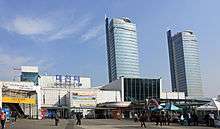Daejeon
Daejeon (Korean: [tɛ̝.dʑʌn] (![]()
Daejeon 대전시 | |
|---|---|
| Daejeon Metropolitan City 대전광역시 | |
| transcription(s) | |
| • Hangul | 대전광역시 |
| • Hanja | 大田廣域市 |
| • Revised Romanization | Daejeon-gwangyeoksi |
| • McCune-Reischauer | Taejŏn-kwangyŏksi |
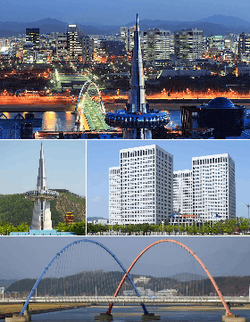 Top:Panorama view of Expo Gwahakgongwon Park and downtown Dunsandong area, Middle left:Hanbit Tower in Daejeon Expo Science Park, Middle right:Daejeon Government Complex area in Jung-gu, Bottom:Expo Bridge | |
 Flag  Seal | |

| |
| Country | |
| Region | Hoseo |
| Districts | 5 |
| Government | |
| • Type | Mayor–council |
| • Mayor | Heo Tae-jeong (Democratic) |
| • Body | Daejeon Metropolitan Council |
| Area | |
| • Total | 539.85 km2 (208.44 sq mi) |
| Population (January, 2019) | |
| • Total | 1,508,120 |
| • Density | 2,800/km2 (7,200/sq mi) |
| • Dialect | Chungcheong |
| ISO 3166 code | KR-30 |
| Flower | White magnolia |
| Tree | Pine |
| Bird | Korean magpie |
| GDP | US$ 39.6 billion[1] |
| GDP per capita | US$25,976[1] |
| Website | Daejeon Metropolitan Government Daejeon Metropolitan Council |
Daejeon is one of South Korea's administration hubs with the Daejeon Government Complex (Other administrative hubs: Seoul, Gwacheon and Sejong City). The Korean administration in the 1980s decided to relocate some of its functions from Seoul, the national capital, to other cities. Currently, 12 national government offices, including Korea Customs Service, Small and Medium Business Administration, Public Procurement Service, National Statistical Office, Military Manpower Administration, Korea Forest Service, Cultural Heritage Administration, and Korean Intellectual Property Office, as well as Patent Court of Korea, are located in Daejeon. Korail, Korea Water Resources Corporation, and Korea Minting and Security Printing Corporation are also headquartered in the city.
Daejeon has 18 universities, including KAIST and Chungnam National University. Daejeon has earned its name as "Asia's Silicon Valley" and "high technology city".[3] The city hosted the Taejon Expo '93 and the International Mathematical Olympiads in 2000. Several important research institutes are based in the city.[3]
Daedeok Innopolis (Daedeok Research and Development Special Zone) is composed of 28 government-funded research institutions, as well as 79 private research institutes with as many as 20,000 researchers. In addition, Daejeon established the World Technopolis Association (WTA) in 1998 with the view of realizing regional development through international cooperation with world science cities. The WTA has grown to have 67 members from 32 countries, and it actively cooperates with many international organizations including UNESCO as its official consultative body.
History
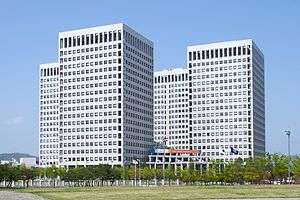
Human beings first settled in the Daejeon region during the Stone Age. It was occupied and in use as strategic military ground in various times by people such as the Usul-gun of Baekje, Bipung-gun of Silla, and the Hoideok-hyeon, Yuseong-hyeon, Deokjin-hyeon, and Jinjam-hyeon. During the Joseon Kingdom period, it remained occupied by the Hoideok-hyeon and Jinjam-hyeon of Gongju Mokha. In 1895, most of the area was made part of Hoideok-gun and Jinjam-gun, excluding some parts that belonged to Gongju-gun.[4]
The Daejeon area was historically known as Hanbat (한밭),[5] a native Korean term for "large field", during the Joseon Dynasty. "Daejeon" simply means the same thing in Hanja. In the 19th century, Daejeon was also known in English as Kung-tsiou.[6]
Historically, Daejeon was a small village without many residents. However, in 1905, the Gyeongbu Railway began operations from Seoul to Busan, opening a station at Daejeon. In 1926 under the rule of the Japanese government, the Honam Railway was built between Mokpo and Daejeon, transforming the latter into a major transportation hub. Because of its location and proximity to means of transportation, Daejeon grew quickly.
In 1932, the capital of Chungnam province was moved from Gongju to Daejeon. During the Korean War, the city was the site of an early major conflict: the Battle of Taejon.
Since then, changes have been made to the city's boundaries. Its official names have evolved, as well. Among the boundary modifications include one that effectively made the nearby town of Daedeok a part of the city in 1983. Then, in the late 1980s, Daejeon was elevated to the status of Special City (Jikhalsi), thus became a separate administrative region from Chungcheongnam-do. In 1995, all South Korean Special Cities were again renamed as Metropolitan Cities, which is reflected in the current official name of Daejeon, Daejeon Metropolitan City (대전광역시).
In 1997, the Daejeon Government Complex was constructed as part of an effort to move some government offices away from the densely populated capital, Seoul.[7] The population of Daejeon increased dramatically as a result.[8]
Geography
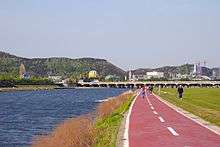
Daejeon lies between latitudes N36°10'50" and N36°29'47" and longitudes E127°14'54" and E127°33'21" near the middle of South Korea. It is 167.3 km (104.0 mi) from Seoul, 294 km (183 mi) from Busan and 169 km (105 mi) from Gwangju. Sejong, which is planned to be the new administrative capital of South Korea, is also close by. The city lies inside a great circle and is surrounded by several mountains, and Gyeryongsan National Park straddles the city border to the west. The city is divided into five boroughs: Seogu (서구), Donggu (동구), Yuseonggu (유성구), Daedeokgu (대덕구), and Junggu (중구). Three streams flow through the city from south to north, eventually joining with the Geum River: Gapcheon (갑천), Yudeungcheon (유등천), and Daejeoncheon (대전천).
Climate
Daejeon has a monsoon-influenced, four-season climate that lies within the transition between the humid subtropical and humid continental climatic regimens (Köppen Cwa/Dwa, respectively). Monthly mean temperatures range from −1.0 °C (30.2 °F) in January to 25.6 °C (78.1 °F) in August.
| Climate data for Daejeon (1981–2010, extremes 1969–present) | |||||||||||||
|---|---|---|---|---|---|---|---|---|---|---|---|---|---|
| Month | Jan | Feb | Mar | Apr | May | Jun | Jul | Aug | Sep | Oct | Nov | Dec | Year |
| Record high °C (°F) | 16.6 (61.9) |
21.1 (70.0) |
26.1 (79.0) |
30.4 (86.7) |
33.3 (91.9) |
35.2 (95.4) |
37.7 (99.9) |
38.9 (102.0) |
33.2 (91.8) |
29.4 (84.9) |
25.5 (77.9) |
18.4 (65.1) |
37.7 (99.9) |
| Average high °C (°F) | 4.0 (39.2) |
7.0 (44.6) |
12.6 (54.7) |
19.2 (66.6) |
24.1 (75.4) |
27.5 (81.5) |
29.0 (84.2) |
29.8 (85.6) |
26.4 (79.5) |
20.9 (69.6) |
13.3 (55.9) |
6.4 (43.5) |
18.4 (65.1) |
| Daily mean °C (°F) | −1.0 (30.2) |
1.5 (34.7) |
6.5 (43.7) |
13.0 (55.4) |
18.2 (64.8) |
22.4 (72.3) |
25.0 (77.0) |
25.6 (78.1) |
21.3 (70.3) |
14.7 (58.5) |
7.5 (45.5) |
1.2 (34.2) |
13.0 (55.4) |
| Average low °C (°F) | −5.4 (22.3) |
−3.5 (25.7) |
1.0 (33.8) |
7.0 (44.6) |
12.6 (54.7) |
17.9 (64.2) |
21.8 (71.2) |
22.2 (72.0) |
17.1 (62.8) |
9.4 (48.9) |
2.5 (36.5) |
−3.4 (25.9) |
8.3 (46.9) |
| Record low °C (°F) | −18.6 (−1.5) |
−19.0 (−2.2) |
−10.7 (12.7) |
−2.9 (26.8) |
3.1 (37.6) |
8.1 (46.6) |
13.0 (55.4) |
12.3 (54.1) |
4.2 (39.6) |
−2.9 (26.8) |
−11.4 (11.5) |
−17.7 (0.1) |
−19.0 (−2.2) |
| Average precipitation mm (inches) | 29.6 (1.17) |
34.2 (1.35) |
55.6 (2.19) |
81.7 (3.22) |
103.7 (4.08) |
206.3 (8.12) |
333.9 (13.15) |
329.5 (12.97) |
169.7 (6.68) |
47.4 (1.87) |
41.1 (1.62) |
25.9 (1.02) |
1,458.7 (57.43) |
| Average precipitation days (≥ 0.1 mm) | 8.5 | 6.7 | 8.4 | 7.7 | 8.7 | 10.5 | 17.1 | 16.0 | 9.8 | 5.8 | 7.9 | 8.8 | 115.9 |
| Average snowy days | 10.2 | 5.9 | 3.3 | 0.0 | 0.0 | 0.0 | 0.0 | 0.0 | 0.0 | 0.1 | 2.4 | 7.6 | 29.6 |
| Average relative humidity (%) | 64.8 | 59.5 | 56.5 | 55.3 | 62.1 | 68.7 | 77.7 | 77.5 | 74.4 | 70.4 | 66.9 | 66.4 | 66.7 |
| Mean monthly sunshine hours | 163.4 | 172.2 | 200.3 | 212.3 | 223.9 | 180.6 | 139.8 | 157.8 | 168.2 | 195.9 | 161.6 | 162.6 | 2,138.7 |
| Percent possible sunshine | 52.7 | 56.1 | 54.0 | 54.0 | 51.2 | 41.3 | 31.4 | 37.6 | 45.1 | 56.1 | 52.5 | 53.9 | 48.0 |
| Source: Korea Meteorological Administration[9][10][11] (percent sunshine and snowy days)[12] | |||||||||||||
Administrative divisions
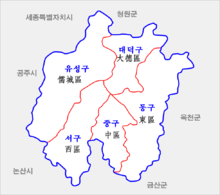
Daejeon is divided into 5 districts ("Gu"):
Demographics
As of January 2019, Daejeon has a population of 1,508,120, including 18,184 (1.2%) registered residents of foreign nationality.[13]

Religion
Religion in Daejeon (2005)[14]
According to the census of 2005, of the people of Daejeon, 21.8% follow Buddhism and 31.2% follow Christianity (20.5% Protestantism and 10.7% Catholicism).[14] About 47% of the population is mostly not religious or follows Muism and other indigenous religions.
Education
Daejeon Science High School is a selective high school focused on teaching science.[15]
Daejeon Foreign Language High School is a selective high school focusing on teaching of foreign language. The school provides language education of 7 majors including English, German, French, Spanish, Chinese, Japanese, and Russian.
Taejon Christian International School is an international school in the city.
KAIST is an institution of higher education focused on research in science and technology. It was ranked as the best Asian science and technology school by Asiaweek in 2000.[16]
Chungnam National University, a major national university established for the South Chungcheong province, Pai Chai University, which is one of the oldest private universities in South Korea, and Woosong University, and Mokwon University are in the city.
Hannam University, in O-Jeong Dong, is another university in the city. It has plans to enlarge its campus in the next few years by expanding into a campus it acquired from the neighbouring Taejon Christian International School, which is now in the Techno Valley area in northern Daejeon.
Research and development
Known as the Silicon Valley of Korea, Daejeon is the home of private and public research institutes, centers and science parks. The R&D centers of Samsung, Institute of Information Technology Advancement, LG, Korea University of Science and Technology, Electronics and Telecommunications Research Institute and others are in Daedeok Science Town in Yuseong-gu.
Daejeon features a technology cluster known as Daedeok Innopolis defined by the national Universities Korea Advanced Institute of Science and Technology (KAIST) and Chungnam National University and surrounded by government research institutes, government-invested corporate research institutes, corporate research centers, and venture companies.
The research institutes and universities in Daedeok Valley have spun off multiple startups. Korea has invested heavily in building up the research expertise for over 30 years, creating long-term research programs. Over 7,000 Ph.D researchers are in the sciences in Daedeok[17] and it had the most application for patents during 2000–2011 among the National Industrial Complex.
Researchers and businessmen work in the fields of telecommunications, nanofabrication, biotechnology, water, nuclear and hydro power, nuclear fusion, design, measurement technologies, mechanical engineering, fuel cells, aeronautics, new materials, robotics, new drugs, and environmental technologies. Daedeok Innopolis' membership includes 898 corporations, 35 government-invested and sponsored institutions; six universities, and 15 public organizations.
Among Daedeok Innopolis' universities, KAIST is considered the top technical university in Korea. Strong fields at KAIST include computer science, electrical and nuclear engineering, mechanical design, chemistry, and telecommunications. Chungnam National University also plays a central role in those fields, and brings expertise in biotechnology, medicine, and the agricultural sciences. These universities are complemented by institutions such as Hanbat National University, Pai Chai University, Hannam University, Mokwon University, and Woosong University.
Research institutes in Daedeok include the Korea Research Institute of Bioscience and Biotechnology (KRIBB), the Korea Atomic Energy Research Institute (KAERI), Electronic and Telecommunications Research Institute (ETRI), Korea Aerospace Research Institute (KARI), Korea Astronomy and Space Science Institute (KASI), Korea Fusion Energy Research Institute (KFERI), National Nanofab Center, Korea Basic Science Institute (KBSI), Institute for Basic Science (IBS), Korea Institute of Machinery and Materials (KIMM), Korea Research Institute of Chemical Technology (KRICT), Korea Institute of Science and Technology Information (KISTI), Korea Research Institute of Standards and Science (KRISS), Marine and Ocean Engineering Research Institute, Institute of Information Technology Advancement (IITA), Korea Institute of Geosciences and Mineral Resources, Agency for Defense Development (ADD), Korea Institute of Toxicology (KIT), Korea Institute of Oriental Medicine, Korea Institute of Nuclear Non-proliferation and Control, National Institute for Mathematical Sciences (NIMS), Korea Institute of Nuclear Safety (KINS), Rare Isotope Science Project (RISP), National Research Foundation of Korea (NRF), and the National Security Research Institute. Among the technology produced in Daedeok are ETRI's wireless communications systems CDMA, WIBRO, and DMB, KRIBB's nano biochips, KARI's KOMPSAT satellites, and NFRI's KSTAR nuclear fusion experimental reactor [18].
Daedeok is also home to 21 corporate research centers with global reach surrounded by an equal number of smaller firms. Some of the notable corporate research centers are Dongbu Advanced Research Institute (biotechnology, microorganisms and agrichemicals), GS-Caltex Value Creation Center (environmentally friendly products including substitutes for oil), Hanwha Chemical Research (biotechnology, electronics materials, catalysts, and nanotechnology), Honam Petrochemical Daeduk Research Institute (synthetic chemistry and petrochemicals), LG Chemical LTD. Research Park (lithium ion battery and polymer battery development), Samyang R&D Center (medical research and electronics), and SK Institute of Technology (petroleum-related research).
Public corporation research institutes such as Korea Electric Power Research Institute (hydroelectric projects and nuclear energy), Korea Institute of Construction Materials (authorized test agency for construction materials), and Korea Institute of Aerospace Technology (aerospace design, satellites, launch technologies) are also part of the Daedeok system.
On 16 May 2013, Daejeon was selected as the core of the International Science and Business Belt. [19]
Besides a tire production facility, Hankook Tire has its main R&D centre in Daejeon.[20]
Culture
Parks and museums
.jpg)
In 1993 an international exposition (Taejŏn Expo '93) was held at Daejeon. The Expo Bridge was designed by Hui Lee Shun. Several landmarks, such as the Hanbit Tower and the Expo Bridge, were built at this time. After the exposition ended, the grounds were refurbished as Expo Science Park. While the tower and some buildings remain, most of the expo buildings have now been removed. As of 2018, the site is hosting the headquarters complex for the Institute for Basic Science.[21] Next to the park is the National Science Museum, which had moved to its current location in 1990.[22]
There are eight popular places for sightseers which are designated by city government.[23] Those eight sights include the mountains Sikjangsan, Bomunsan, Gubongsan (구봉산), Jangtaesan, and Gyejoksan, the lake Daecheonghosu, as well as Yuseong Spa, and Expo Science Park.
Most of the cultural centres and sight seeing places are located in Yuseong-gu district with the exception of Ppuri park and Daejeon Zoo.
Daejeon O-World, Daejeon's local amusement park, consists of Daejeon Zoo, Joy Land and Flower Land. Opened on May 1, 2009 the park is home to 160 species of 600 animals, 17 rides and themed gardens including Sounds garden, Herb Garden, and Rose Garden.
The Daejeon Art & Culture Complex, located in Dunsan Amusement Park, is an art museum focused on the convergence of art and technology. Since it was established in 1998, numerous exhibitions on contemporary art have been held. Another important cultural institution is the Daejeon Philharmonic Orchestra, which performs in Daejeon Culture & Arts Center and other local venues, and which recently completed several international tours, including visits to the United States and Japan.
Media
Daejeon is a provincial center for the television, newspaper and publishing industries.
Major television broadcasting companies, such as KBS and MBC, have branches in Daejeon; Taejon Broadcasting Corporation (TJB) is a local television broadcaster based in Daejeon. Cable TV services are available in most apartments. Eight (8) channels of Mobile TV are provided with the digital radio channels. Several FM radio stations provide news and music on the air. KBS, MBC, TJB have their FM radio channels, there are Christian radio channels, FEBC and CBS, and traffic news channel TBN.
Daejeon Ilbo is a local newspaper which covers South Chungcheong province.
Festival
Daejeon Science Festival, which symbolizes the science city of Daejeon, is a representative festival. The Hyo Culture Root Festival, Daejeon International Wine Fair, Yuseong Oncheon Festival, Geumgang Rojas Festival, Diku Festival, Gyejoksan Mountain Manbal Festival and Gyeonwoojik Women Festival will be held.[24]
Sports
The Daejeon World Cup Stadium was constructed in preparation for the 2002 FIFA World Cup. Several games have been held there, including the South Korea vs. Italy match in the second round. It is also the current home of the K League 2 football club Daejeon Citizen FC. The K3 League side Daejeon Korail FC is also based in the city, playing at the Daejeon Hanbat Sports Complex.
The Hanwha Eagles of the KBO League play their home games at Daejeon Baseball Stadium in Busa-dong.
The city is home to LPGA golfers Pak Se-ri and Jang Jeong. Daejeon is also the hometown of former New York Mets left-handed reliever Dae-Sung Koo.
Transportation
Daejeon is a center of transportation in South Korea, where two major expressways, Gyeongbu Expressway and Honam Expressway, and two major railway lines, Gyeongbu railway and Honam railway, are joined. Travel time between Daejeon and Seoul using the KTX high-speed rail system is about 50 minutes. The nearest airport to Daejeon is Cheongju Airport, about a thirty-minute drive north of Daejeon. However, there are also direct bus connections to Incheon International Airport.
Subway
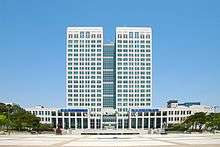
One line, Daejeon Subway Line 1, of a planned five-line subway system has been operating since April 17, 2007 (partial operations on this line began on March 16, 2006). This subway line connects Daejeon Station, located in the original city center, with the more modern and more recently developed sections of this city, including Dunsan, where the city hall and a number of national government buildings are located.
Notable differences between the Daejeon subway and the Seoul subway include narrower cars, no doors connecting cars, four cars per train rather than ten, and storage space under the seats for use by passengers.[25] Originally, plastic tokens for toll were read by a proximity sensor when entering the turnstiles, and then inserted into a slot when exiting. The design of the tokens allowed them to be used for advertising.[26] The system now employs the T-money system, a rechargeable series of smart cards and other "smart" devices used for paying transportation fares. Platform screen doors are installed in the subway stations.
Gallery
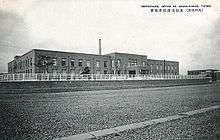 South Chuncheong Provincial Office in 1920s.
South Chuncheong Provincial Office in 1920s. Government offices for the South Chungcheong province in 2007
Government offices for the South Chungcheong province in 2007- Daejeon Station in 1920s
 Daejeon train station in 2007
Daejeon train station in 2007- Eunhaeng-Sunhwa neighborhood in 1920s
Notable people

- Kim Joon-ho, comedian
- Do Ji-han (actor)
- Choi Sung-bong
- Chung Eun-yong
- Han Eun-jung
- Han Sang-hyuk, singer (VIXX)
- Hong Jin-ho
- Ivy
- Kwon Sang-woo
- Lee Yoon-ki, film director
- Micky Yoochun
- Rhie Won-bok, cartoonist
- Pak Se-ri
- Shin Chaeho
- Shin Seung-hun
- Song Joong-ki
- Chen, singer (Exo)
- Kyu Ha Kim
- Baek Ye-rin, singer (15&)
- Park Ji-min, singer (15&)
- Jo Bo-ah
- Park Eun-ooh
- Choi Jung-in
- Kim Woo-seok, singer (X1)
Twin towns – sister cities
| City | Region | Country | Year |
|---|---|---|---|
| Oda | 1987 | ||
| Seattle | 1989 | ||
| Budapest | 1994 | ||
| Nanjing | Jiangsu[27] | 1994 | |
| Calgary | 1996 | ||
| Guadalajara[28] | 1997 | ||
| Uppsala | 1999 | ||
| Novosibirsk | 2001 | ||
| Brisbane | 2002 | ||
| Bình Dương Province[27] | 2005 | ||
| Sapporo | 2010 | ||
| Durban | 2011 | ||
| Purwokerto | 2014 | ||
| Bandung | 2015 | ||
| Siem Reap | Siem Reap Province[27] | 2019 | |
See also
References
Citations
- "Global city GDP 2014". Brookings Institution. Archived from the original on 4 June 2013. Retrieved 18 November 2014.
- "Population, Households and Housing Units". Korean Statistical Information System. Korea National Statistical Office. Retrieved 2007-02-28.
- Song-Du-Bum (July 2000). "Scientific-industrial and nucleus administrative city, Daejeon". GukTo(country). 7 (225): 70.
- http://www.daejeon.go.kr/dre/DreContentsHtmlView.do?menuSeq=2732
- 선사시대의대전 [Prehistoric War] (in Korean). Daejeon.go.kr. Archived from the original on 2014-01-13. Retrieved 2014-03-22.
- EB (1878), p. 390.
- "Daejeon Government Complex". Government Buildings Management Service. Retrieved 2007-02-22.
- Oh, Changyeop (2006-03-22). "Daejeon, Larger Population than Gwangju". Prometheus (in Korean). Archived from the original on 2007-09-28. Retrieved 2007-02-22.
이러한 대전의 인구증가 요인은 지난 1998년 정부대전청사 이전과 한국철도공사, 특허법원, 대덕연구단지 등이 자리를 잡은 것과 관련이 있다.
- 평년값자료(1981–2010) 대전(133) (in Korean). Korea Meteorological Administration. Retrieved 21 December 2016.
- 기후자료 극값(최대값) 전체년도 일최고기온 (℃) 최고순위, 대전(133) (in Korean). Korea Meteorological Administration. Retrieved 21 December 2016.
- 기후자료 극값(최대값) 전체년도 일최저기온 (℃) 최고순위, 대전(133) (in Korean). Korea Meteorological Administration. Retrieved 21 December 2016.
- "Climatological Normals of Korea" (PDF). Korea Meteorological Administration. 2011. p. 499 and 649. Archived from the original (PDF) on 7 December 2016. Retrieved 21 December 2016.
- "Population statistics 4th Quarter 2018".
- 2005 Census - Religion Results Archived 2015-09-04 at the Wayback Machine
- "Daejeon Science High School" (in Korean). Retrieved 2007-02-21. High schools in South Korea usually do not require special entrance exams.
- "Asia's Best Universities 2000". Asiaweek. 2000-06-30. Retrieved 2007-02-21.
- ko:대덕연구단지
- https://www.nfri.re.kr/eng/index
- 공감코리아(sympathyKorea) (21 March 2012). "Management Division International Science and Business Belt implementation plan, 2012". 공감코리아(sympathyKorea) archive. publish in book form: 1–93 [4]. Retrieved 7 April 2013.
- "Hankook Tire Review – Enfren Tires". Trucktrend.com. 2008-12-17. Retrieved 2014-03-22.
- "Information on Relocation of IBS HQ". www.ibs.re.kr. HQ Relocation Team. 21 December 2017. Retrieved 17 January 2018.
- "History". National Science Museum of Korea. Retrieved 2007-02-28.
- 8 good places Archived 2009-03-02 at the Wayback Machine
- "대전관광". www.daejeon.go.kr. Retrieved 2019-05-31.
- "Riding Daejeon Subway". iris's talk on above 18 & computers & and society (in Korean). 2006-05-08. Retrieved 2007-02-28.
- "Visiting Daejeon Subway". Korean Faction (in Korean). 2006-03-17. Archived from the original on 2007-01-03. Retrieved 2007-02-28.
뒷면에는 대전소재 배재대학교의 광고가 새겨져있었습니다.
- These subdivisions do not have their own flags.
- "Sister Cities, Public Relations". Guadalajara municipal government. Archived from the original on March 2, 2012. Retrieved March 12, 2013.
Bibliography
- , Encyclopædia Britannica, 9th ed., Vol. VI, New York: Charles Scribner's Sons, 1878, pp. 390–394.
External links
| Wikimedia Commons has media related to: |
| Wikivoyage has a travel guide for Daejeon. |
- "2015년 인구주택총조사 전수집계결과 보도자료" [2015 Population and Housing Census]. Statistics Korea.


